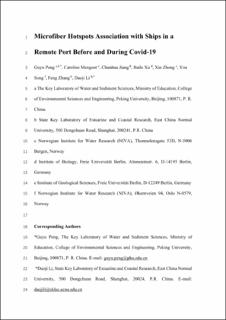| dc.contributor.author | Peng, Guyu | |
| dc.contributor.author | Mengeot, Caroline | |
| dc.contributor.author | Jiang, Chunhua | |
| dc.contributor.author | Xu, Baile | |
| dc.contributor.author | Zhong, Xin | |
| dc.contributor.author | Song, You | |
| dc.contributor.author | Zhang, Feng | |
| dc.contributor.author | Li, Daoji | |
| dc.date.accessioned | 2023-06-13T10:06:53Z | |
| dc.date.available | 2023-06-13T10:06:53Z | |
| dc.date.created | 2023-06-02T08:43:28Z | |
| dc.date.issued | 2023 | |
| dc.identifier.citation | ACS ES&T Water. 2023, 3 (5), 1275-1285. | en_US |
| dc.identifier.issn | 2690-0637 | |
| dc.identifier.uri | https://hdl.handle.net/11250/3071088 | |
| dc.description | Embargoed until 3. May 2024. | en_US |
| dc.description.abstract | During monthly water quality monitoring of Norwegian coastal waters, the sea surface waters off Brønnøysund, a remote port in Norway, exhibited an unexpectedly high abundance of microfibers. We further conducted monitoring of microplastics and microfibers from the surface waters off the city before and during the Covid-19 pandemic. Analysis of the microfiber characteristics, which were primarily comprised of cellulosic and polyester fibers, revealed similarities with those found in the global ocean, but at concentrations that were 1–4 orders of magnitude higher, with the maximum concentration reaching 491 n/L (0.34 mg/L). Source apportionment of microfibers using multivariate analyses based on simultaneous water chemistry data showed positive correlations with ships. Contrary to previous assumptions that marine microfibers were derived from land-based sources, our findings revealed that gray water discharge from ships significantly contributed to microfibers in the oceans. The demonstrated causations using path modeling between microfibers, gray water, shipping, and noncargo shipping activities call for urgent research and regulatory actions toward addressing plastic pollution in the UN Decade of Ocean Science. | en_US |
| dc.language.iso | eng | en_US |
| dc.publisher | ACS Publications | en_US |
| dc.title | Microfiber Hotspots’ Association with Ships in a Remote Port before and during Covid-19 | en_US |
| dc.type | Peer reviewed | en_US |
| dc.type | Journal article | en_US |
| dc.description.version | acceptedVersion | en_US |
| dc.rights.holder | Copyright © 2023 American Chemical Society | en_US |
| dc.source.pagenumber | 1275-1285 | en_US |
| dc.source.volume | 3 | en_US |
| dc.source.journal | ACS ES&T Water | en_US |
| dc.source.issue | 5 | en_US |
| dc.identifier.doi | 10.1021/acsestwater.2c00382 | |
| dc.identifier.cristin | 2151047 | |
| cristin.ispublished | true | |
| cristin.fulltext | postprint | |
| cristin.qualitycode | 1 | |
